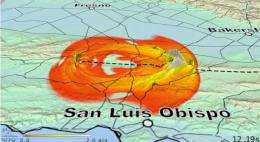SEED project to enable rapid video encoding and dissemination

The San Diego Supercomputer Center (SDSC) at the University of California, San Diego, has been awarded a three-year, $810,000 grant from the National Science Foundation (NSF) to develop a resource that lets researchers seamlessly share and stream scientific visualizations on a variety of platforms, including mobile devices.
The new project, named SEED for 'Swiftly Encode, Explore, Disseminate,' provides an essential yet missing component in computational research and the current high-performance computing (HPC) infrastructure.
"We will be creating a cyberinfrastructure to fill these gaps by using a combination of hardware and software that will enable rapid sharing, exploration, video encoding, and dissemination of visualization content on the Web directly from HPC resources," said Amit Chourasia, a senior visualization scientist at SDSC and principal investigator for the project.
Computational simulations have become an indispensable tool for researchers in a wide variety of areas, from neurosurgical planning to better predicting the impact of earthquakes. As these simulations increase in complexity, resolution and duration, visualization of their results has become important in rapid assessment of the data. In addition, collaborative analysis of simulation and observational data by multiple researchers or groups is emerging across myriad research communities.
The result of many visualization processes is a set of image sequences, which can be encoded as a movie and distributed within and beyond the research groups doing the simulations. However, the encoding process of such movies is a computationally intensive, cumbersome and complicated process as well as one that each research group must undertake.
Moreover, sharing visualizations within and outside various research groups requires additional time and effort. While the growth in portable wireless devices has made it possible to access information anywhere and at any time, researchers say the application of this capability for use in computational research and outreach has been negligible.
"Currently, it takes us at least one day of turn-around time just to share visualization results with the domain scientists without any support for portable devices," said Chourasia. "This delay could be quite costly to domain scientists, who in some cases may run additional simulations with slightly different initial conditions without being able to adequately assess prior results. More importantly, the laborious process involved in sharing all results, even within a single research group, may lead to subpar investigation."
The project capitalizes on recent strides in video standardization across Web-based communities. "Our goal for SEED is to convert a manual, serial, error-prone process into an automatic, easy-to-use streamlined, parallel and web accessible cyberinfrastructure, while providing a significant speed-up in video encoding by using parallel-distributed processing, which is not possible on existing HPC platforms due to lack of state-of-the-art video compression tools on Linux-like operating systems," added Chourasia.
"The current HPC infrastructure relies heavily on controlled access," said Michael Norman, SDSC's director and co-principal investigator for the project. "SEED will provide secure input and public output complementing HPC resources without compromising their security model. We believe SEED will have a transformative impact throughout numerous domains, as research has become increasingly collaborative, requiring better tools and resources that aid the sharing of information."
The SEED project will be done in partnership with Globus Online, a software-as-a-service for secure and reliable data movement developed by the Computation Institute at the University of Chicago and Argonne National Laboratory. Globus Online will enable parallel data transfer from many HPC resources.
"Enabling researchers to move data quickly and securely from various sources to the SEED infrastructure is a critical element of this project," said Steve Tuecke, Globus Online co-founder and deputy director of the Computation Institute. "Globus Online's high-performance file transfer capabilities, coupled with its ease of use and growing popularity on XSEDE and other HPC resources, will help ensure broader and faster access to the SEED infrastructure."
The default H.264 compliant video encoding – currently the industry standard for video compression or the process of converting digital video into a format that takes up less capacity when it is stored or transmitted – will be used by SEED, resulting in better user experience because it is widely supported. The researchers plan to release a set of scientific visualizations to promote benchmarking of video encoding from image sequences, which is currently missing.
As an open, web-accessible and searchable archive of visualizations, SEED will be suitable for education and outreach programs. In addition to organizing tutorials, talks, and webinars to promote SEED, train new users, and receive user feedback, the program will provide internships to high school and undergraduate students enabling them to learn about web technologies and the diverse range of research, while at the same time support monitoring of content on the project website.
Provided by University of California - San Diego
















